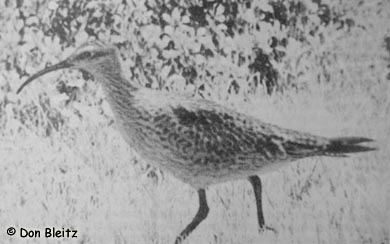This is the sixth in a series of posts on birds at risk in Canada. The Committee on the Status of Endangered Wildlife in Canada (COSEWIC) lists 73 bird species as endangered, threatened or of special concern.
This is a cautionary tale. A tale of how quickly a species numbering in the millions can disappear. Although they are still listed on our endangered list and shown in bird guides, the chance of actually spotting an Eskimo Curlew is likely the same as spotting an Ivory-billed woodpecker. In other words, there is no chance.

Eskimo Curlew Numenius borealis
The only known photographs of a living Eskimo curlew were taken in 1962 on Galveston Island, TX. These images may represent the entire photographic record of this species in the wild.
BirdLife International says:
This species has not been recorded with certainty since the early 1980s (and none have been confirmed on the wintering grounds since 1939). It was formerly abundant, but declined rapidly over a century ago as a result of hunting and habitat loss. However, it cannot yet be presumed to be Extinct until all potential breeding areas have been surveyed, and the series of occasional unconfirmed reports ceases. Any remaining population is likely to be tiny, and for these reasons it is treated as Critically Endangered (Possibly Extinct).
The Eskimo Curlew was/is a mottled brownish shorebird with long legs and a fairly long, thin, slightly down-curving bill. Its upper parts are brown, while its breast and abdomen are buff. It has a solid brown crown and cinnamon coloured under-wings. They resemble the more common Whimbrel, but are much smaller (pigeon-sized).
These shorebirds bred on the treeless tundra of the Northwest Territories. They migrated westward across Canada to the east coast, and down through the Caribbean to the Argentinean pampas and other South American countries. Their return migration was up through Central America, across the Gulf of Mexico to the Texas coast, and northwards through the prairies.
The historic population was estimated to be in the hundreds of thousands, if not in the millions, before 1860, but declined dramatically in the 1870s to 1890s, and the species was almost extinct by 1900.
It was reported in southern migrations to have visited Newfoundland in millions that darkened the sky. One observer in 1860 reported a flock a mile long and nearly as wide. A single flock alighting in Nebraska was said to have covered 40-50 acres.
These birds were said to weigh ‘almost a pound, but only when fat’. They were often called dough birds, as well as prairie pigeons.
During the years 1870-1900, the railroads were completed and a rapid increase in the population of the prairie states took place. Considered a table delicacy, the Eskimo curlew took the place of the already slaughtered passenger pigeon in the marketplace of the settlers. Its lack of suspicion and fear, plus its habit of traveling in huge numbers, made it extremely vulnerable. When farmers and hunters were confronted with acre upon acre of ‘dough birds’, they didn’t realize they were looking at a considerable portion of the entire species.
Eskimo curlews were shot over their entire migration route, with a record of 7,000 shot in one day in Nantucket. Hunting of these birds was banned in 1916, but add the numbers killed in North America to those shot on the Argentina grasslands, and the result was inevitable.
Over hunting combined with the conversion of the prairies to agriculture proved to be insurmountable obstacles in the recovery of the little Eskimo curlew. The last accepted record of living Eskimo curlews was a small flock of 23 birds seen in Texas in 1981 (BirdLife International).
Sources:
BirdLife International
Extinct & Vanishing Birds of The World, James C Greenway Jr, 1967
Audubon Encyclopaedia of North American Birds, John K Terres, editor, 1991



I sure hope there’s a small population of these guys in the world. Much of the areas where they migrated are currently sparsely populated. With so few birds and such a wide, mostly unpopulated migration and breeding route, it might be possible that the species struggles on with little notice, especially since just about everyone has given up on it. Another issue is that so many people are not versed in identifying shorebirds and can’t tell the difference between a whimbrel or an Eskimo curlew. Actually, most people can’t even tell the difference between a plover and sandpiper, either.
One thing I would like to see, say these birds are really extinct, is genetic work on this species. There is talk of cloning some recently extinct birds and scientists have found the closest living relatives of several species (some of which were unexpected, such as in the case of the passenger pigeon and the band-tailed pigeon). I know, for me, I would like to see how closely related the Eskimo curlew is to the little curlew and whether they are conspecific (subspecies) to each other.
Another insightful post on the demise (I remain optimistic) of such a gorgeous bird. Again, humans have proven to be the main factor in the possible eradication of another species. The data does not look good, but I will remain hopeful that this species is still around. Just heart breaking when I think about it.